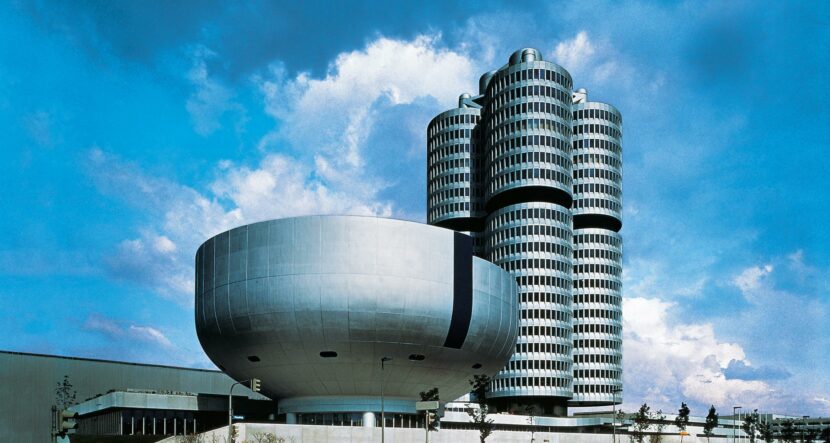To many BMW fans, the BMW Museum is the ultimate destination. Located in Munich and parked directly opposite the BMW Welt, it showcases and contextualizes BMW products throughout the brand’s history. Since 1973 – with a brief closure for renovations from 2004 until 2008 – the BMW Museum has dazzled millions of visitors with a veritable history lesson of the brand. In fact, more than five million visitors have come through the doors just since re-opening in 2008. Here’s some history and background on the BMW Museum, with an obligatory look at some of the building’s most prestigious residents.
1973 – 2004; Original BMW Museum

The first BMW Museum – the iconic bowl-shaped building – was designed by Karl Schwanzer, a Viennese professor and architect. Schwanzer designed the facility to be completely round, envisioning the continuation of the road in an enclosed space. What began as a few “souvenirs on display, but not for sale” in a single room at the Munich Plant in 1922 led to the plant’s own official museum by 1966. Increasing visitor traffic demanded a purpose-built space to accommodate the exhibitions, and on May 18, 1973, the BMW Museum opened.
The BMW Museum Today


As mentioned, the BMW Museum closed from 2004 until 2008 to expand and renovate. The original BMW Museum is now referred to as the Museum Bowl – or, “the Bowl.” The 1,000-square-meter space now serves as a home for temporary exhibits. Elsewhere, visitors are treated to over 4,000 square meters of permanent exhibitions, comprising around 110 selections plucked from the company’s timeline. Guided tours are offered in German and English. Despite largely falling under the arm of the automaker’s BMW Classic division, the Museum even has its own app.
Another update completed in April 2024, modernizing the lobby and bringing what BMW calls a ‘futuristic’ feel. New ticket machines were introduced, as were welcoming additions like a wall of plants and a more open-air theme. BMW hopes to ease employee workloads and improve overall accessibility with these additions. Exhibitions range from celebrating 100 years of Motorrad to showcasing hydrogen power and circularity. While the exhibits rotate, there’s never a dull moment.
The Most Important BMWs in History


Never a dull moment, indeed. Here’s one most will recognize: a Fire Orange E92 M3 GTS. While it sadly never made it stateside, it’s the most aggressive E92 M3 BMW offered. Only 150 made it through production. Power increased to 444 hp and 325 pound-feet of torque, gains of 30 each. A roll cage, race seats, an Alcantara-wrapped steering wheel, and a fire extinguisher are just some of the added features.


Almost as orange, nowhere near as fast. Despite lacking modern-day performance credentials, this 1968 2002 ti practically invented the term “sports coupe.” A rev-happy inline four-cylinder engine and just-right sizing put many of the contemporary American cars – and European competitors – to shame. In more ways than one; the 2002 was a clear winner in dynamics and fuel economy. It also had more space and a much more comfortable cabin.


Maybe a less comfortable cabin, but who doesn’t love an Isetta? The microcar birthed from BMW’s financial crisis of the 1950s was actually an Italian design licensed by BMW. BMW tweaked some engine components and badging and let it rip. The “motocoupe,” as it was marketed, was a hit.


And then there’s this BMW 328. Produced from 1936 until 1940, it’s one of a relatively few pre-war vehicles. The coupe used an early straight-six engine developing around 80 horsepower, accelerating to speeds of up to 93 mph. It was a class winner at Mille Miglia in 1938 and 24 Hours of Le Mans in 1939.


Lastly, something for the Elvis fans out there. One of many famous 507 owners, this is the real Elvis car restored by BMW Classic professionals. Part of the House of Technology exhibit, the car was extensively restored and even repainted using in-period methods instead of more modern approaches. This car was painstakingly and carefully brought back to factory specs. And we’re not just saying that – a previous owner had gone as far as ripping out the engine in favor of a Chevrolet big-block, a hilariously American decision.
Peruse the rest of the album, and you’ll find quirky rides like the BMW Z1 and its gorgeous descendant, the Z8, among many others. There’s even a deconstructed i3 and a variety of engines and motorcycles on display. Oh, and Nick Heidfeld’s racing suit from the BMW Sauber days. Like we said – never a dull moment. [Photos: Dan Levins @klapped.media]
